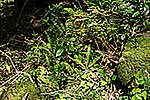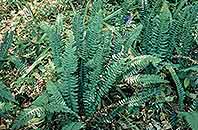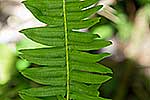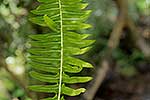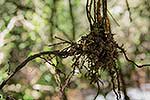Blechnum australe L. ssp. australe
Synonyms |
Blechnum australe L. var. aberrans N.C.Anthony & Schelpe |
|---|---|
Common name |
|
Description |
Rhizome thin (3-20 mm), creeping widely, ending in a thickened, erect portion; rhizome scales dark brown, ovate-lanceolate in outline, apex tapering to a point, 2-10 x 0.2-2 mm, margins entire. Fronds tufted, dimorphic. Stipe 2-20 cm long, pale brown and glabrous at maturity but with scales similar to the rhizome at the base. Sterile lamina (6-) 28-56 cm × (1-)3.5-13 cm, pinnate with reduced basal pinnae and narrowly elliptic in outline; pinnae lanceolate, joined to the rhachis at least basally, glabrous or thinly grandular, margin entire to minutely serrate, apex mucronate. Fertile lamina same size or somewhat longer than the sterile lamina; pinnae linear, with the bases remaining lobed, basal pinnae often not fertile. Sori linear, limited to the middle part of the fertile lamina; indusium continuous, erose or lacerate, 0.3-0.8 mm wide. |
Notes | B. australe can be distinguished from B. punctulatum by fertile fronds that are generaly longer than sterile ones, sori that are present only in the central pinna region and the adnate to sessile base of the pinnae in the sterile lamina. B. australe also has sharply pointed mucronate pinnae tips. |
Derivation | australe: southern, of the south (botanists thought this fern to be limited to the southern areas of Africa). |
Habitat | Terrestrial in forest margins or lithophyte in rock crevices or at base of boulders along mountain streams, sun or shade. |
Distribution worldwide | Africa, Madagascar, Tristan da Cuñha, Gough and Ascension Islands. |
Distribution in Africa |
Kenya, Lesotho, Malawi, Namibia, South Africa, Swaziland, Tanzania , Zimbabwe, Zimbabwe. |
Growth form |
Lithophytic, terrestrial. |
Literature |
|
